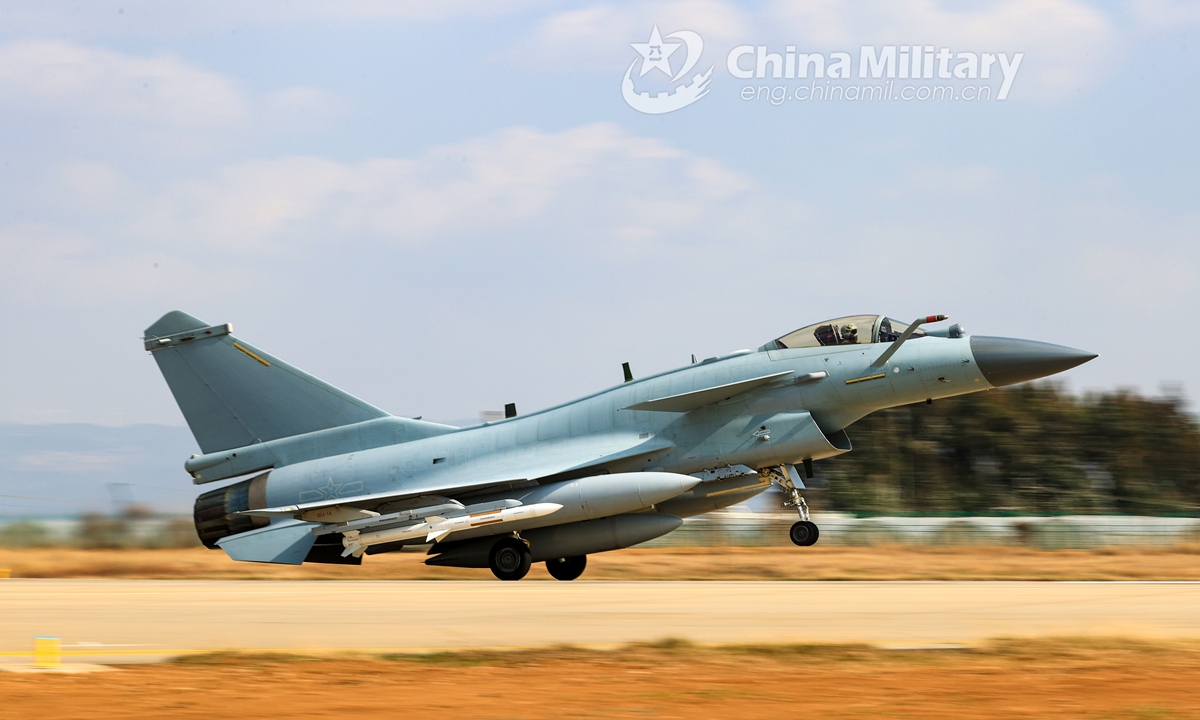
A J-10 fighter jet attached to an aviation brigade of the air force under the PLA Southern Theater Command takes off from the runway during a day-into-night flight training exercise on February 2, 2021. The exercise is focused on training items like tactical formation flight, simulated aerial combat, etc.Photo:China Military
The recent surfacing of images of the J-10C fighter jets with the marking of the Pakistan Air Force on social media seems to have verified a widely-circulated hearsay that Pakistan ordered advanced J-10C fighter jets from China.
While there has been no official confirmation about Pakistan's purchase of J-10C jets, Pakistani Interior Minister Sheikh Rasheed Ahmed announced at the end of last year that the Pakistan Air Force would perform a fly-past using 25 J-10C fighter jets to be imported from China during Pakistan's Republic Day parade on March 23.
Unsurprisingly, much of the attention from the media has focused on how the latest acquisition of the supersonic jets could boost Pakistan's military and national defense, but it is worth noting that closer defense cooperation between China and Pakistan is always of great significance to the advancement of their manufacturing ability.
While it is unknown whether the J-10C deal will involve supply chain transfer or other areas of cooperation, the jets' usage and maintenance will have the potential to accelerate an upgrade of Pakistan's defense industry.
Take the bilateral cooperation over the Xiaolong fighter as an example. China and Pakistan have a long history of cooperation when it comes to joint development and manufacturing of the light fighter project. In fact, the JF-17 Thunder, also known as FC-1 Xiaolong, which was jointly developed by the Pakistan Aeronautical Complex and Chengdu Aircraft Industry Group of China, has already become a good example as to how defense cooperation between the two friendly peoples has enhanced the manufacturing strength in Pakistan.
After years of research and development partnership with Chinese peers, Pakistan's aviation industry has registered a considerable improvement. Now Pakistan has the capability to independently manufacture the Xiaolong fighter aircraft, which is uncommon among developing countries.
While there are no statistics available on how many JF-17 Thunder jets Pakistan has exported so far, it is no secret that the country has become a defense exporter with JF-17 being the mainstay of its arms exports. The development is sufficient to demonstrate the rapid development of Pakistan's aviation industry aided by China's assistance.
As the aviation industry has always been regarded as representing a country's high-end equipment manufacturing strength, it can be said that China-Pakistan cooperation in the aviation area is of great significance to Pakistan's manufacturing sector progress.
Meanwhile, China has also benefited from the close defense collaboration with Pakistan. Pakistan is the first foreign buyer of China's J-10C fighter jet, which is equipped with China's domestically developed WS-10B Taihang turbofan engines.
Therefore, the exports of the first batch of J-10C fighter jets will reassure all the potential buyers that the aircraft model has overcome all technical difficulties.
The export of military equipment is closely related to the development of a country's manufacturing power, as the manufacturing of military equipment belongs to a high-end category. In other words, if China can continue to achieve constant progresses in military equipment manufacturing and export, which indicates that the country's overall manufacturing strength has reached a new and high level.




